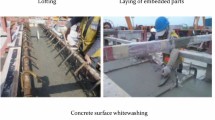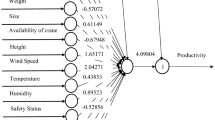Abstract
The productivity estimation of construction machinery is a significant challenge faced by many earthmoving contractors. Traditionally, contractors have used manufacturers’ catalogues or have simply relied on the site personnel’s experiences to estimate the equipment production rates. However, various studies have demonstrated that typically, there are large differences between the estimated and real values. In the construction research domain, linear regression and neural network methods have been considered as popular tools for estimating the productivity of equipment. However, linear regression cannot provide very accurate results, while neural network methods require an immense volume of historical data for training and testing. Hence, a model that works with a small dataset and provides results that are accurate enough is required. This paper proposes a generalized linear mixed model as a powerful tool to estimate the productivity of Komatsu D-155A1 bulldozers that are commonly used in many earthmoving job sites in different countries. The data for the numerical analysis are collected from actual productivity measurements of 65 bulldozers. The outputs of the proposed model are compared with the results obtained by using a standard linear regression model. In this manner, the capabilities of the proposed method for accurate estimations of productivity rates are demonstrated.
Similar content being viewed by others
References
Alwi, S. (2003). “Factors influencing construction productivity in the Indonesian context.” Proc., 5th EASTS Conference, Fukuoka, Japan.
Anon, G. D. (1997). Caterpillar performance handbook, Caterpillar Inc., Illinois, IL, USA.
Berk, R. A. (2004). Regression analysis: A constructive critique, Sage Publications, Inc., Thousand Oaks, CA, USA.
Cerny, P. A. (2001). “Data mining and neural networks from a commercial perspective.” ORSNZ (Operational Research Society of New Zealand) Conference Twenty Naught One, Christchurch, New Zealand.
Chao, L. C. and Skibniewski, M. (1994). “Estimating construction productivity: Neural-network-based approach.” Journal of Computing in Civil Engineering, ASCE, Vol. 8, No. 2, pp. 234–251.
Demidenko, E. (2004). Mixed models: Theory and applications, John Wiley & Sons, New York, NY, USA.
Durbin, J. and Watson, G. S. (1971). “Testing for serial correlation in least squares regression III.” Biometrika, Vol. 58, No. 1, pp. 1–19.
Edwards, D. J. and Holt, G. D. (2000). “ESTIVATE: A model for calculating excavator productivity and output costs.” Engineering, Construction and Architectural Management, Vol. 7, No. 1, pp. 52–62.
Elazouni, A. M. and Basha, I. M. (1996). “Evaluating the performance of construction equipment operators in Egypt.” Journal of Construction Engineering and Management, ASCE, Vol. 122, No. 2, pp. 109–114.
Freedman, D. A. (2009). Statistical models: Theory and practice, Cambridge University Press, New York, NY, USA.
Glantz, S. A. and Slinker, B. K. (1990). Primer of applied regression and analysis of variance, McGraw-Hill, ISBN 0-07-023407-8.
Han, S. W., Hong, T. H., and Lee, S. Y. (2008). “Production prediction of conventional and global positioning system-based earthmoving systems using simulation and multiple regression analysis.” Canadian Journal of Civil Engineering, Vol. 35, No. 6, pp. 574–587.
Haykin, S. (1999). Neural networks: A comprehensive foundation, 2nd Edition, Prentice Hall, McMaster University Hamilton, Ontario, Canada.
Jazebi, F. and Rashidi, A. (2013). “An automated procedure for selecting project managers in construction firms.” Journal of Civil Engineering and Management, Volume 19, Issue 1, pp. 97–106.
Karshenas, S. and Xin, F. (1992). “Application of neural networks in earthmoving equipment production estimating.” Proc., 8th Conference in Computing in Civil Engineering and Geographic Information Systems, ASCE, New York, NY, pp. 841–847.
Komatsu, S. (2003). Specifications and application handbook, 24th Edition, Komatsu Publications and Training Group, Tokyo, Japan.
Littell, R., Stroup, W., and Freund, R. (2002). SAS for linear models, From: http://faculty.ucr.edu/~hanneman/linearr_models/c4.html.
Mehrotra, K., Mohan, C. K., and Ranka, S. (1997). Elements of artificial neural networks, MIT Press, Cambridge, Massachusetts, M.A, USA.
Moavenzadeh, F. and Koch Rossow, J. A. (1975). The construction industry in developing countries, Technology Adaptation Program, Massachusetts Institute of Technology, Cambridge, Massachusetts, M.A, USA.
Neuhaus, J. W., McCulloch, C. E., and Shayle, R. S. (2008). Generalized, linear, and mixed models, Wiley-Interscience, New York, NY, USA.
Nunnally, S. W. (2000). Managing construction equipment, 2nd Edition, Prentice-Hall, Pearson Education, Inc., Upper Saddle River, New Jersey, NJ, USA.
Panas, A. and Pantouvakis, J. P. (2010). “Evaluating research methodology in construction productivity studies.” The Built & Human Environment Review, Vol. 3, No. 1, pp. 63–85.
Parsakhoo, A., Hosseini, S. A., Lotfalian, M., and Jalilvand, H. (2009). “Efficiency and cost analysis of forestry machinery usage in Hyrcanian Forests of Iran.” World Applied Sciences Journal, Vol. 6, No. 2, pp. 227–233.
Rabe-Hesketh, S. and Everitt, B. S. (2006). Handbook of statistical analysis using stata, BocaRaton, FL: Chapman & Hall/CRC.
Rashidi, A., Rashidi Nejad, H., and Behzadan, A. H. (2009). “Multiple linear regression approach for productivity estimation of bulldozers.” Proc., 3rd International Conference on Construction Engineering and Management and 6th International Conference on Construction Project Management (ICCEM&ICCPM), Jeju, South Korea.
Rashidi, A., Jazebi, F., and Brilakis, I. (2011). “Neuro-fuzzy genetic system for selection of construction project managers.” Journal of Construction Engineering and Management, Vol. 137, No. 1, pp. 17–29.
Rencher, C. A. and Schaalje, G. Bruce (2008). Linear models in statistics, John Wiley & Sons, Inc., New York, NY, USA.
Schabowicz, K. and Hoła, B. (2007). “Mathematical-neural model for assessing productivity of earthmoving machinery.” Journal of Civil Engineering and Management, Vol. 13, No. 1, pp. 47–54.
Schabowicz, K. and Hoła, B. (2008). “Application of artificial neural networks in predicting earthmoving machinery effectiveness ratios.” Journal of Archives of Civil and Mechanical Engineering, Vol. 8, No. 4, pp. 73–84.
Seung, C. O. and Sinha, S. K. (2006). “Construction equipment productivity estimation using artificial neural network model.” Journal of Construction Management and Economics, Vol. 24, pp. 1029–1044.
Shi, J. J. (1999). “A neural network based system for predicting earthmoving production.” Journal of Construction Management and Economics, Vol. 17, No. 4, pp. 463–471.
Smith, S. D. (1999). “Earthmoving productivity estimation using linear regression techniques.” Journal of Construction Engineering and Management, ASCE, Vol. 125, No. 3, pp. 133–141.
Smith, S. D., Wood, G. S., and Gould, M. (2000). “A new earth works estimating methodology.” Journal of Construction Management and Economics, Vol. 18, No. 2, pp. 219–228.
Stanish, W. and Taylor, N. (1983). “Estimation of the intraclass correlation coefficient for the analysis of covariance model.” American Statistician, Vol. 37, pp. 221–224.
Tam, C. M., Tong, T. K. L., and Tse, S. L. (2002). “Artificial neural networks model for predicting excavator productivity.” Journal of Engineering, Construction and Architectural Management, Vol. 9, Nos. 5–6, pp. 446–452.
Tu, J. V. (1996). “Advantages and disadvantages of using artificial neural networks versus logistic regression for predicting medical outcomes.” Journal Clin. Epidemiol., Vol. 49, No. 11, pp. 1225–1231.
UCLA: Statistical Consulting Group. (2013). Introduction to generalized linear mixed models, From: http://www.ats.ucla.edu/stat/mult_pkg/glmm.htm.
Author information
Authors and Affiliations
Corresponding author
Rights and permissions
About this article
Cite this article
Rashidi, A., Nejad, H.R. & Maghiar, M. Productivity estimation of bulldozers using generalized linear mixed models. KSCE J Civ Eng 18, 1580–1589 (2014). https://doi.org/10.1007/s12205-014-0354-0
Received:
Revised:
Accepted:
Published:
Issue Date:
DOI: https://doi.org/10.1007/s12205-014-0354-0




